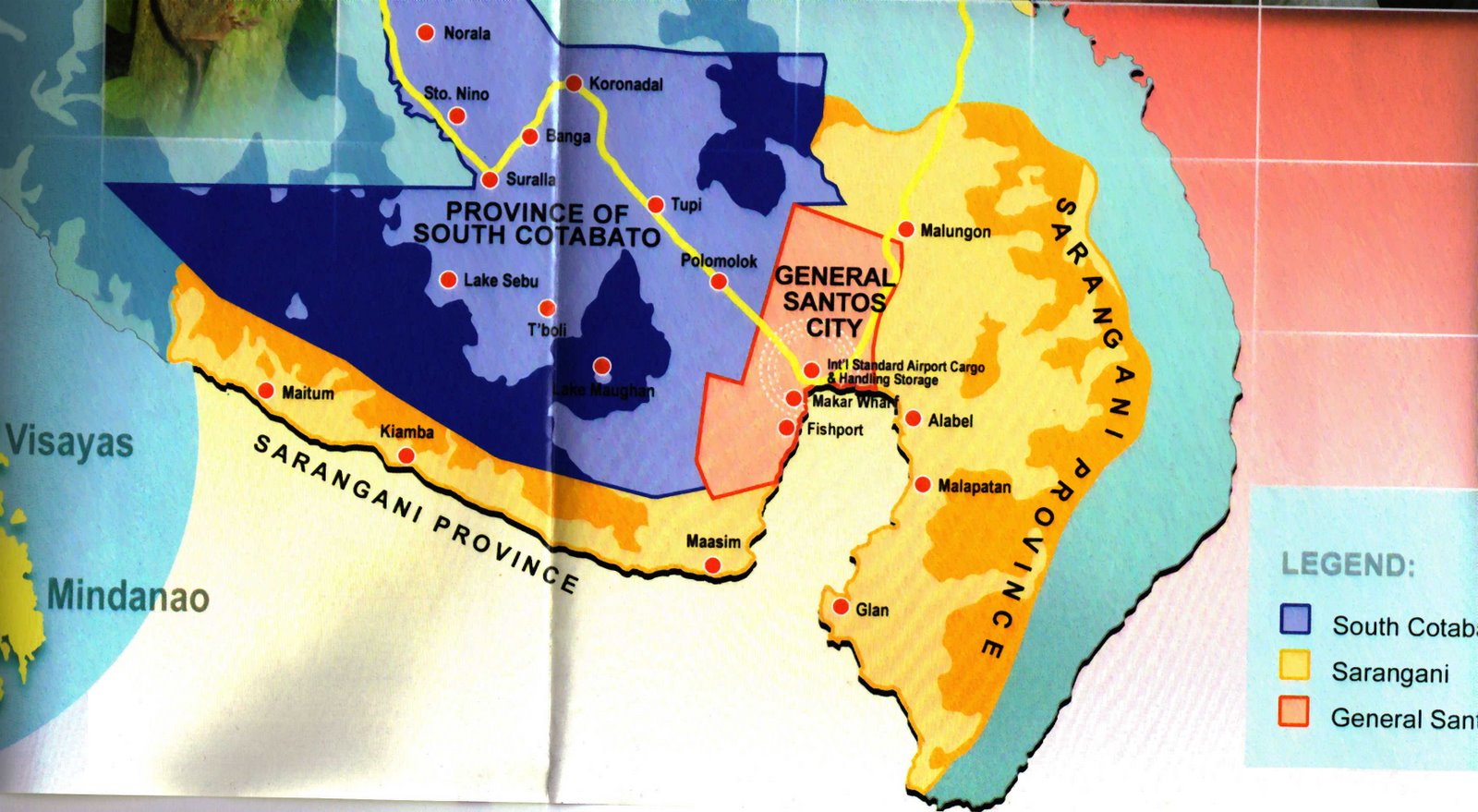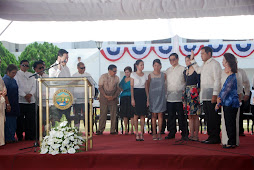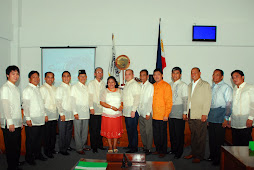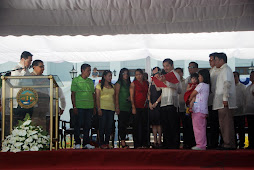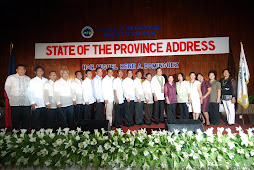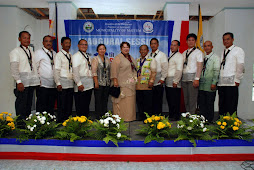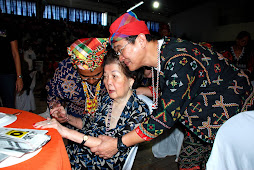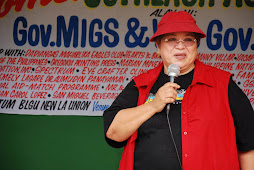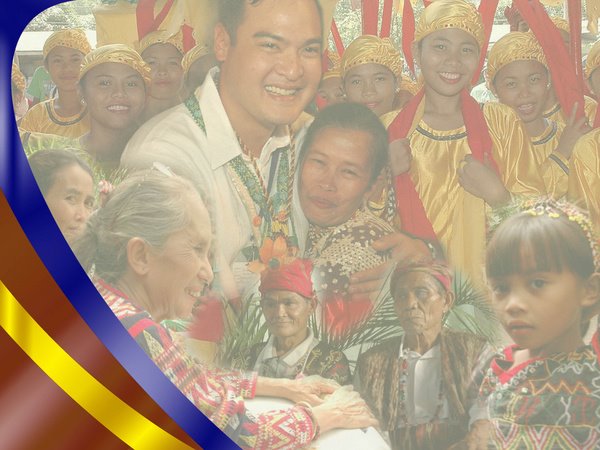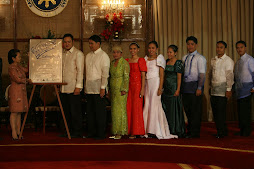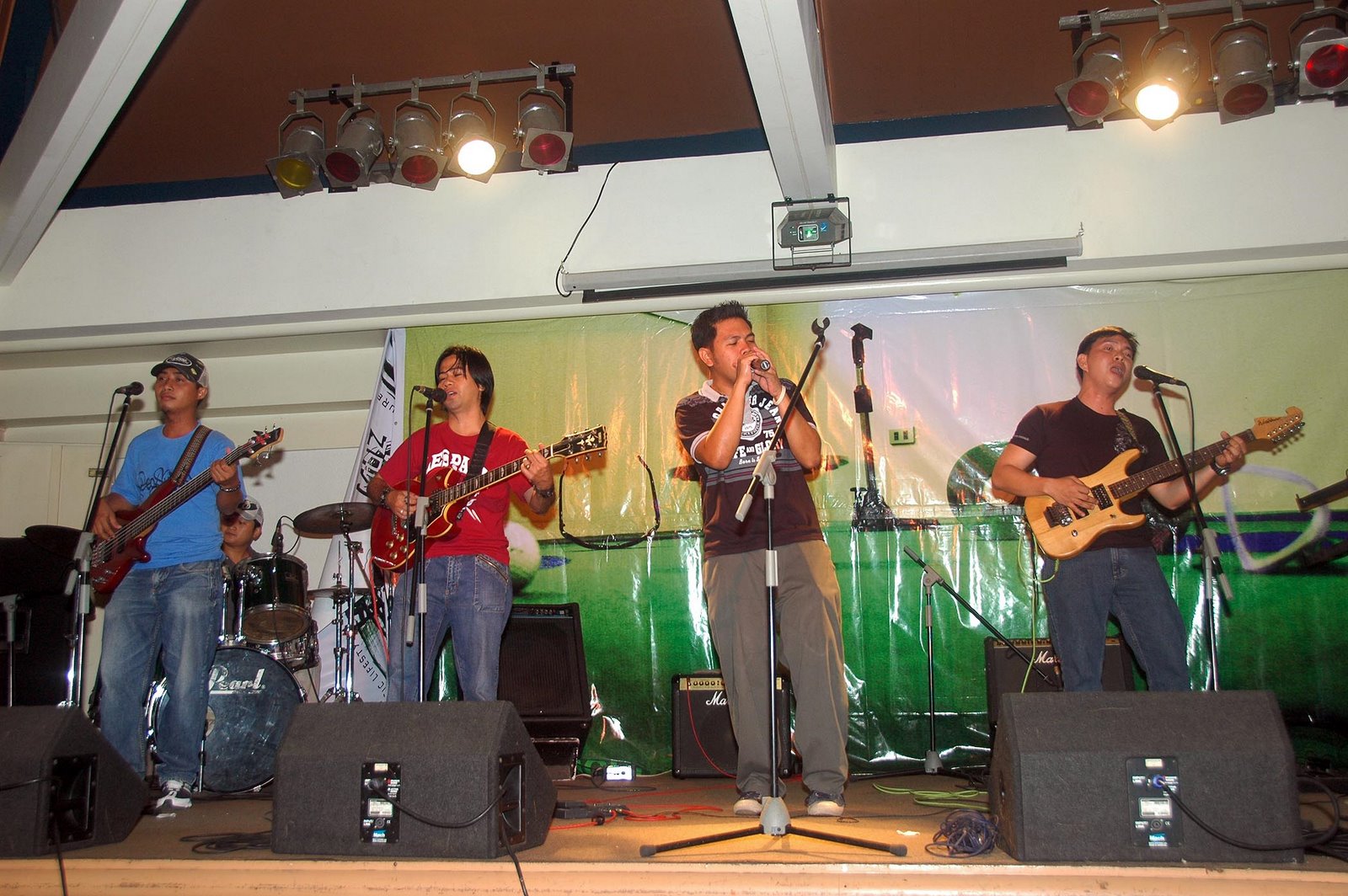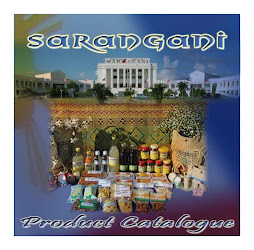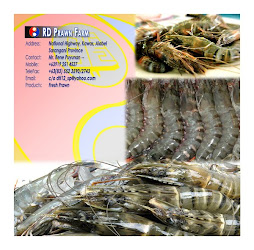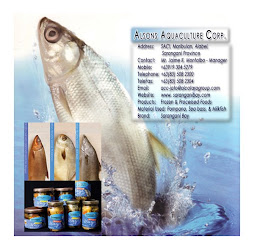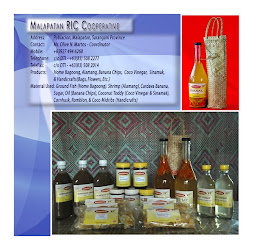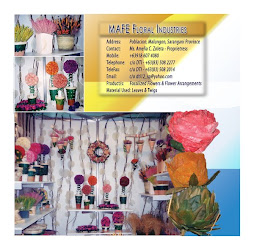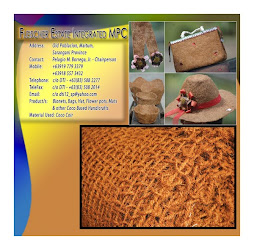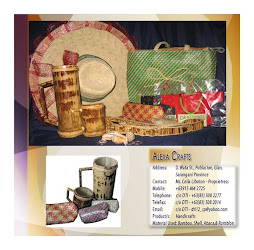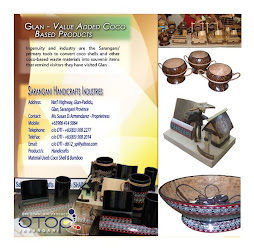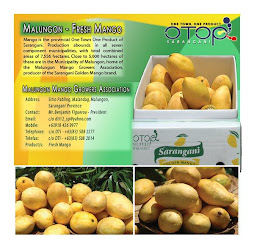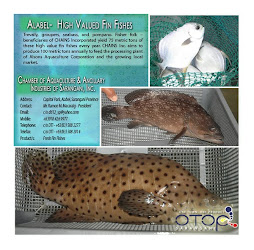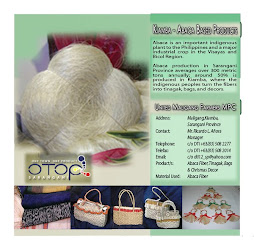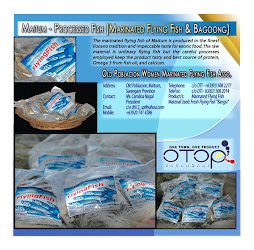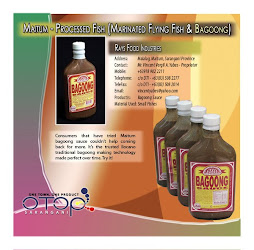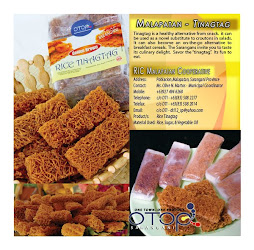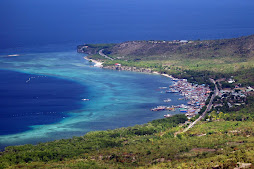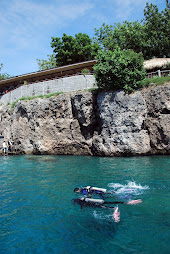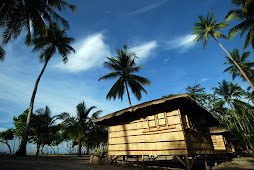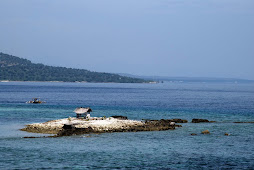 MAITUM, Sarangani (October 31, 2009) - Gov. Migs Dominguez graces the Division Science Quest, Fair, and Camp during its opening day. He encouraged the delegates to excel in their studies "because the future lies on you." He also commended the organizers for choosing Maitum as the venue because "tourism in Maitum has a lot to offer." The activity was attended by more than 1,000 high school students and elementary pupils from the seven municipalities of Sarangani Province. (MAITUM INFORMATION OFFICE)
MAITUM, Sarangani (October 31, 2009) - Gov. Migs Dominguez graces the Division Science Quest, Fair, and Camp during its opening day. He encouraged the delegates to excel in their studies "because the future lies on you." He also commended the organizers for choosing Maitum as the venue because "tourism in Maitum has a lot to offer." The activity was attended by more than 1,000 high school students and elementary pupils from the seven municipalities of Sarangani Province. (MAITUM INFORMATION OFFICE)Friday, October 30, 2009
Science Quest, Fair and Camp
 MAITUM, Sarangani (October 31, 2009) - Gov. Migs Dominguez graces the Division Science Quest, Fair, and Camp during its opening day. He encouraged the delegates to excel in their studies "because the future lies on you." He also commended the organizers for choosing Maitum as the venue because "tourism in Maitum has a lot to offer." The activity was attended by more than 1,000 high school students and elementary pupils from the seven municipalities of Sarangani Province. (MAITUM INFORMATION OFFICE)
MAITUM, Sarangani (October 31, 2009) - Gov. Migs Dominguez graces the Division Science Quest, Fair, and Camp during its opening day. He encouraged the delegates to excel in their studies "because the future lies on you." He also commended the organizers for choosing Maitum as the venue because "tourism in Maitum has a lot to offer." The activity was attended by more than 1,000 high school students and elementary pupils from the seven municipalities of Sarangani Province. (MAITUM INFORMATION OFFICE)Quick response
 MAITUM, Sarangani (October 31, 2009) - Members of the Municipal Disaster Coordinating Council Quick Response Team conduct a disaster preparedness drill to more than 1,000 high school and elementary pupils during the Division Science Quest, Fair, and Camp last week in this municipality. (MAITUM INFORMATION OFFICE)
MAITUM, Sarangani (October 31, 2009) - Members of the Municipal Disaster Coordinating Council Quick Response Team conduct a disaster preparedness drill to more than 1,000 high school and elementary pupils during the Division Science Quest, Fair, and Camp last week in this municipality. (MAITUM INFORMATION OFFICE)
Farm-to-market road
 MAITUM, Sarangani (October 31, 2009) - Mayor Elsie Perrett (2nd from right) leads the groundbreaking of the rehabilitation of a 1.3-kilometer farm-to-market road in barangay Kalaneg on October 22. The road rehab work worth P500,000 is funded by the Department of National Defense and undertaken by the Philippine Army 73rd Infantry Battalion and Engineering Brigade. (MAITUM INFORMATION OFFICE)
MAITUM, Sarangani (October 31, 2009) - Mayor Elsie Perrett (2nd from right) leads the groundbreaking of the rehabilitation of a 1.3-kilometer farm-to-market road in barangay Kalaneg on October 22. The road rehab work worth P500,000 is funded by the Department of National Defense and undertaken by the Philippine Army 73rd Infantry Battalion and Engineering Brigade. (MAITUM INFORMATION OFFICE)
New opportunity in weaving seen for Blaan community
By Joy Sevilla
MALUNGON, Sarangani (October 31, 2009) - The Lamlifew Tribal Women’s Association (LTWA) in barangay Datal Tampal in the town of Malungon has a promising future with the introduction of utilizing processed silk instead of abaca fibers in making indigenous fabrics.
Aside from it is done easier and faster with silk, the effort of Blaan weavers in coming up with native fabrics would also be financially rewarding as fabrics made out of silk are more expensive that its price is almost twice higher when sold.
October 22, 2009 marked the “day of change” for the weavers of LTWA. Two master weavers of the Iban tribe from Sarawak, Malaysia visited the Lamlifew Village Museum for the exchange of knowledge about their respective culture and learn from each other’s experiences particularly in weaving.
The four-day visit, which ended on October 25, was one of the projects of Rosevida Alcantara Dominguez, mother of Sarangani Governor Migs Dominguez.
During the first day of the visit-workshop, the master weavers named Nancy Ngali and Bangie Embol, together with Alfonso Guinoo, a Davaoeño who promotes hand-woven fabrics, his Chinese friend, Edric Ong, a renowned textile designer in Southeast Asia, and Mrs. Dominguez, were welcomed by Blaan artists in the community through a cultural dance.
Both Blaans and the visitors expressed their gratitude for the conduct of the workshop which later brought out further skills and mastery of the Blaan weavers.
The visitors showed samples of their fabrics made of silk and also brought out with them some materials and equipment to be used in the activity.
Ong said, the Malaysian weavers had been using cotton for weaving fabrics for several years, but currently, they are also using silk because they realized how better it is to produce fabrics out of such material.“For silk weaving, you can demand higher price. We sell fabrics out of silk to those who want to hang it as a piece of art. For foreign ladies from Europe, America, and Japan, they buy the product and use it as shawl,” he said. “Processed silk fiber is taken from cultured worms and it is imported from China.”
Mrs. Dominguez, on the other hand, was also thankful that the Blaan weavers openly accepted the idea of having the workshop. She said introducing change is good without attempting to change the culture of the tribe.“What we just want to introduce is how to have a better quality fabric. Sometimes, it is also good that some people teach us to make things better. With this new learning, we hope that more women will be interested and be engaged in the activity because they will be able to see how easy the weaving process is done using the material,” she asserted.She added that the introduction of silk in weaving is also an advantage to children in the community because at their young age, they will realize the benefits of using silk compared to abaca fibers.She could provide the materials needed should the Blaan weavers want to sustain and continue the use of silk for weaving.
Getting along with the Malaysian weavers is more interesting than just see them weave. It was learned that they got similar patterns with the Blaans in weaving. A few terminologies of the materials used in Blaan weaving were also similar to that of the Malaysians such as blileh, a flattened piece of wood which is used for tightening the fabrics.
Nancy said they also have several trees and plants in their community which they use for natural dyeing. She greatly appreciated how the Blaan weavers do in coming up with abaca strands that she even tried it herself.
Nancy often does the talking than Bangie when interacting with the local people in the community as she knows how to speak English language. But Bangie was observed to be more talkative when she and Nancy were left alone.
In their last day in the community, Bangie said she had a very good encounter during the workshop, while Nancy said she could not forget the treatment she experienced in the community.“Here, we often eat, we easily get fat,” she said smiling. She added in Malaysia, they do not eat much rice. She was amazed that in the Lamlifew community, they eat rice thrice a day excluding the heavy snacks of kamote (sweet potato) or banana.Such kind of visit is the first ever one since the Lamlifew Village Museum was established in 2007.
The community further hopes to meet people who do not only help them grow in their craft, but also fill them with knowledge through exchanging culture practices and experiences that they could never forget. (Joy Sevilla/SARANGANI INFORMATION OFFICE)
MALUNGON, Sarangani (October 31, 2009) - The Lamlifew Tribal Women’s Association (LTWA) in barangay Datal Tampal in the town of Malungon has a promising future with the introduction of utilizing processed silk instead of abaca fibers in making indigenous fabrics.
Aside from it is done easier and faster with silk, the effort of Blaan weavers in coming up with native fabrics would also be financially rewarding as fabrics made out of silk are more expensive that its price is almost twice higher when sold.
October 22, 2009 marked the “day of change” for the weavers of LTWA. Two master weavers of the Iban tribe from Sarawak, Malaysia visited the Lamlifew Village Museum for the exchange of knowledge about their respective culture and learn from each other’s experiences particularly in weaving.
The four-day visit, which ended on October 25, was one of the projects of Rosevida Alcantara Dominguez, mother of Sarangani Governor Migs Dominguez.
During the first day of the visit-workshop, the master weavers named Nancy Ngali and Bangie Embol, together with Alfonso Guinoo, a Davaoeño who promotes hand-woven fabrics, his Chinese friend, Edric Ong, a renowned textile designer in Southeast Asia, and Mrs. Dominguez, were welcomed by Blaan artists in the community through a cultural dance.
Both Blaans and the visitors expressed their gratitude for the conduct of the workshop which later brought out further skills and mastery of the Blaan weavers.
The visitors showed samples of their fabrics made of silk and also brought out with them some materials and equipment to be used in the activity.
Ong said, the Malaysian weavers had been using cotton for weaving fabrics for several years, but currently, they are also using silk because they realized how better it is to produce fabrics out of such material.“For silk weaving, you can demand higher price. We sell fabrics out of silk to those who want to hang it as a piece of art. For foreign ladies from Europe, America, and Japan, they buy the product and use it as shawl,” he said. “Processed silk fiber is taken from cultured worms and it is imported from China.”
Mrs. Dominguez, on the other hand, was also thankful that the Blaan weavers openly accepted the idea of having the workshop. She said introducing change is good without attempting to change the culture of the tribe.“What we just want to introduce is how to have a better quality fabric. Sometimes, it is also good that some people teach us to make things better. With this new learning, we hope that more women will be interested and be engaged in the activity because they will be able to see how easy the weaving process is done using the material,” she asserted.She added that the introduction of silk in weaving is also an advantage to children in the community because at their young age, they will realize the benefits of using silk compared to abaca fibers.She could provide the materials needed should the Blaan weavers want to sustain and continue the use of silk for weaving.
Getting along with the Malaysian weavers is more interesting than just see them weave. It was learned that they got similar patterns with the Blaans in weaving. A few terminologies of the materials used in Blaan weaving were also similar to that of the Malaysians such as blileh, a flattened piece of wood which is used for tightening the fabrics.
Nancy said they also have several trees and plants in their community which they use for natural dyeing. She greatly appreciated how the Blaan weavers do in coming up with abaca strands that she even tried it herself.
Nancy often does the talking than Bangie when interacting with the local people in the community as she knows how to speak English language. But Bangie was observed to be more talkative when she and Nancy were left alone.
In their last day in the community, Bangie said she had a very good encounter during the workshop, while Nancy said she could not forget the treatment she experienced in the community.“Here, we often eat, we easily get fat,” she said smiling. She added in Malaysia, they do not eat much rice. She was amazed that in the Lamlifew community, they eat rice thrice a day excluding the heavy snacks of kamote (sweet potato) or banana.Such kind of visit is the first ever one since the Lamlifew Village Museum was established in 2007.
The community further hopes to meet people who do not only help them grow in their craft, but also fill them with knowledge through exchanging culture practices and experiences that they could never forget. (Joy Sevilla/SARANGANI INFORMATION OFFICE)
Warm welcome
 Alabel, Sarangani (October 31, 2009) – Former Governor Priscilla Chiongbian appreciates the warm welcome that the indigenous people is giving her as she joins their annual celebration of National Indigenous Peoples Thanksgiving Day and witness the signing of the 10-point agreement between the Chiongbian family and the indigenous people of Sarangani.
Alabel, Sarangani (October 31, 2009) – Former Governor Priscilla Chiongbian appreciates the warm welcome that the indigenous people is giving her as she joins their annual celebration of National Indigenous Peoples Thanksgiving Day and witness the signing of the 10-point agreement between the Chiongbian family and the indigenous people of Sarangani.
Tribal parade
 Alabel, Sarangani (October 31, 2009) – Businessman Roy Chiongbian and Provincial Tribal Chieftain Edmund Pangilan lead the tribal parade in celebration of National Indigenous Peoples Thanksgiving Day at the provincial Capitol. Over 600 IP leaders, ministers, women and youth from the seven municipalities attended the celebration.
Alabel, Sarangani (October 31, 2009) – Businessman Roy Chiongbian and Provincial Tribal Chieftain Edmund Pangilan lead the tribal parade in celebration of National Indigenous Peoples Thanksgiving Day at the provincial Capitol. Over 600 IP leaders, ministers, women and youth from the seven municipalities attended the celebration.
The covenant
 Alabel, Sarangani (October 31, 2009) – Former Governor Priscilla Chiongbian (center) and his son Roy Chiongbian (left) together with the new Provincial Tribal Chieftain Edmund Pangilan (right) take amoment with the municipal tribal chieftains and tribal leaders while showing the signed 2009 covenant for the development of the indigenous people in the province. Also in this photo is the grandson of Mommy Priscy, Vice Governor Steve Chiongbian Solon (extreme left).
Alabel, Sarangani (October 31, 2009) – Former Governor Priscilla Chiongbian (center) and his son Roy Chiongbian (left) together with the new Provincial Tribal Chieftain Edmund Pangilan (right) take amoment with the municipal tribal chieftains and tribal leaders while showing the signed 2009 covenant for the development of the indigenous people in the province. Also in this photo is the grandson of Mommy Priscy, Vice Governor Steve Chiongbian Solon (extreme left).
Mommy Priscy
 Alabel, Sarangani (October 31, 2009) – Former Governor Priscilla “Mommy Priscy” Chiongbian receives a hug from the new ProvincialTribal Chieftain Edmund Pangilan (left) and her youngest son RoyChiongbian (right) in celebration of the National Indigenous People Thanksgiving Day and the signing of a 10-point agreement between the indigenous people and the Chiongbian family.
Alabel, Sarangani (October 31, 2009) – Former Governor Priscilla “Mommy Priscy” Chiongbian receives a hug from the new ProvincialTribal Chieftain Edmund Pangilan (left) and her youngest son RoyChiongbian (right) in celebration of the National Indigenous People Thanksgiving Day and the signing of a 10-point agreement between the indigenous people and the Chiongbian family.
Fulong T'mugad
 Alabel, Sarangani (October 31, 2009) – Businessman Roy Chiongbian, the youngest son of the late former Congressman James Chiongbian andformer Governor Priscilla Chiongbian was given the name Fulong T'mugad, a Blaan name which means successor during the tribal ceremony at Capitol gym. Roy Chiongbian as the successor will continue the legacy of public service in the province ofSarangani.
Alabel, Sarangani (October 31, 2009) – Businessman Roy Chiongbian, the youngest son of the late former Congressman James Chiongbian andformer Governor Priscilla Chiongbian was given the name Fulong T'mugad, a Blaan name which means successor during the tribal ceremony at Capitol gym. Roy Chiongbian as the successor will continue the legacy of public service in the province ofSarangani.
Datu Gifu
Thursday, October 29, 2009
Tribal elder
 ALABEL, Sarangani (October 30, 2009) – A tribal elder pays respect to former Governor Priscilla Chiongbian, popularly known by the indigenous people as Mommy Priscy, Thursday, October 29, before a tribal ceremony of acceptance for her youngest son Roy Chiongbian as a follower of his parents in continuing the legacy of public service in the province; and the signing of the 2009 Covenant for Indigenous Peoples' Development among the municipal chieftains and other officials of the seven municipalities. (Cocoy Sexcion/SARANGANI INFORMATION OFFICE)
ALABEL, Sarangani (October 30, 2009) – A tribal elder pays respect to former Governor Priscilla Chiongbian, popularly known by the indigenous people as Mommy Priscy, Thursday, October 29, before a tribal ceremony of acceptance for her youngest son Roy Chiongbian as a follower of his parents in continuing the legacy of public service in the province; and the signing of the 2009 Covenant for Indigenous Peoples' Development among the municipal chieftains and other officials of the seven municipalities. (Cocoy Sexcion/SARANGANI INFORMATION OFFICE)
Roy Chiongbian greets tribal elders
 ALABEL, Sarangani (October 30, 2009) – Businessman Roy Chiongbian greets tribal elders during the National Indigenous People's Thanksgiving Day at the Capitol gym Thursday, October 29, when the indigenous people accepted Roy as their brother and "new adopted" whom they believe can introduce further development in their communities. (Cocoy Sexcion/SARANGANI INFORMATION OFFICE)
ALABEL, Sarangani (October 30, 2009) – Businessman Roy Chiongbian greets tribal elders during the National Indigenous People's Thanksgiving Day at the Capitol gym Thursday, October 29, when the indigenous people accepted Roy as their brother and "new adopted" whom they believe can introduce further development in their communities. (Cocoy Sexcion/SARANGANI INFORMATION OFFICE)
Governor Migs pays respect
 ALABEL, Sarangani (October 30, 2009) – Governor Migs Dominguez pays respect to a tribal elder during the National Indigenous People's Thanksgiving Day at the Capitol gym Thursday, October 29, introducing businessman Roy Chiongbian as the successor of the family in giving assistance to the indigenous people. (Cocoy Sexcion/SARANGANI INFORMATION OFFICE)
ALABEL, Sarangani (October 30, 2009) – Governor Migs Dominguez pays respect to a tribal elder during the National Indigenous People's Thanksgiving Day at the Capitol gym Thursday, October 29, introducing businessman Roy Chiongbian as the successor of the family in giving assistance to the indigenous people. (Cocoy Sexcion/SARANGANI INFORMATION OFFICE)
IPs affirm ties with Chiongbian family
ALABEL, Sarangani (October 29, 2009) - The commitment of the Chiongbian family to continuously support the development of the indigenous people (IPs) in the province was formalized during the National Indigenous People's Thanksgiving Day at the Capitol gym, introducing businessman Roy Chiongbian as the successor of the family in giving assistance to the IPs.
The Thursday (October 29) activity was highlighted with a tribal ceremony of acceptance for Roy Chiongbian as a follower of his parents, the late former Congressman James Chiongbian and former Governor Priscilla Chiongbian, in continuing the legacy of public service in the province; and the signing of the 2009 Covenant for Indigenous Peoples' Development among the municipal chieftains and other officials of the seven municipalities.
During the tribal ceremony, the tribe accepted Roy as their brother and "new adopted" whom they believe can introduce further development in their communities.
The covenant contains the ten-point agreement for IPs' development including the strengthening of tribal councils; literacy development and scholarship program; development of settlement areas for IPs; support for the development of ancestral domain; development of roads and bridges; health, sanitation, potable water and school buildings; livelihood development program; promotion of peace and order; promotion of Sarangani IPs' cultural heritage; and a sectoral seat in Sangguniang Panlalawigan.
Chiongbian, in his speech, pointed out that developing IPs is one of the top priorities of his mother during the latter's governance.
"In 2000, my mother entered into the same agreement, but now that she's no longer in office, my family and I will continue to support you. I am Roy Chiongbian and I am here for you," he said.
As a new brother and member of the tribe, Chiongbian was also given recognition as Datu Gifu by the T'bolis and Fulong Tmugad by the Blaans.
Edmund Pangilan, the newly-installed provincial tribal chieftain, said it is just proper to give conferment to Roy as his family also recognizes the tribe in the province.
Conferment is the act of giving something such as a title or honor or favor to somebody."We gave him the names Datu Gifu and Fulong Tmugad because these names only mean that he will be the one to continue what has been started by his parents for the development of the IPs," Pangilan said. "Nakasalalay na karon sa iyang abaga ang kalamboan sa tribo."
Meanwhile, Datu Caleasa Katug, the municipal tribal chieftain of Maitum, believes that Chiongbian can well perform his obligation for the IPs."Sumala sa among paghimamat sa iyaha, among nakita nga duna g'yud siya'y pagbati," he said, adding that Roy Chiongbian also has the heart for the IPs. (Joy Sevilla/SARANGANI INFORMATION OFFICE)
The Thursday (October 29) activity was highlighted with a tribal ceremony of acceptance for Roy Chiongbian as a follower of his parents, the late former Congressman James Chiongbian and former Governor Priscilla Chiongbian, in continuing the legacy of public service in the province; and the signing of the 2009 Covenant for Indigenous Peoples' Development among the municipal chieftains and other officials of the seven municipalities.
During the tribal ceremony, the tribe accepted Roy as their brother and "new adopted" whom they believe can introduce further development in their communities.
The covenant contains the ten-point agreement for IPs' development including the strengthening of tribal councils; literacy development and scholarship program; development of settlement areas for IPs; support for the development of ancestral domain; development of roads and bridges; health, sanitation, potable water and school buildings; livelihood development program; promotion of peace and order; promotion of Sarangani IPs' cultural heritage; and a sectoral seat in Sangguniang Panlalawigan.
Chiongbian, in his speech, pointed out that developing IPs is one of the top priorities of his mother during the latter's governance.
"In 2000, my mother entered into the same agreement, but now that she's no longer in office, my family and I will continue to support you. I am Roy Chiongbian and I am here for you," he said.
As a new brother and member of the tribe, Chiongbian was also given recognition as Datu Gifu by the T'bolis and Fulong Tmugad by the Blaans.
Edmund Pangilan, the newly-installed provincial tribal chieftain, said it is just proper to give conferment to Roy as his family also recognizes the tribe in the province.
Conferment is the act of giving something such as a title or honor or favor to somebody."We gave him the names Datu Gifu and Fulong Tmugad because these names only mean that he will be the one to continue what has been started by his parents for the development of the IPs," Pangilan said. "Nakasalalay na karon sa iyang abaga ang kalamboan sa tribo."
Meanwhile, Datu Caleasa Katug, the municipal tribal chieftain of Maitum, believes that Chiongbian can well perform his obligation for the IPs."Sumala sa among paghimamat sa iyaha, among nakita nga duna g'yud siya'y pagbati," he said, adding that Roy Chiongbian also has the heart for the IPs. (Joy Sevilla/SARANGANI INFORMATION OFFICE)
wi-fi hall
 KIAMBA, Sarangani (October 28, 2009) - Local and government media covering the ongoing five-day province-wide free medical and surgical mission of the University of Santo Tomas dispatch their respective news items via a wireless internet connection provided by Smart Communications at the mess hall of school-turned-hospital Kiamba Central Elementary School. (Cocoy Sexcion/SARANGANI INFORMATION OFFICE)
KIAMBA, Sarangani (October 28, 2009) - Local and government media covering the ongoing five-day province-wide free medical and surgical mission of the University of Santo Tomas dispatch their respective news items via a wireless internet connection provided by Smart Communications at the mess hall of school-turned-hospital Kiamba Central Elementary School. (Cocoy Sexcion/SARANGANI INFORMATION OFFICE)
Smart personnel
 KIAMBA, Sarangani (October 28, 2009) - Smart Communications employees from network and platform services division and customer experience center conduct a follow-up mangrove planting activity Wednesday, October 28, at barangay Suli. Some four hectares of mangrove area here is one of the seven adopted sites of Smart for its reforestation project in Sarangani. (Cocoy Sexcion/SARANGANI INFORMATION OFFICE)
KIAMBA, Sarangani (October 28, 2009) - Smart Communications employees from network and platform services division and customer experience center conduct a follow-up mangrove planting activity Wednesday, October 28, at barangay Suli. Some four hectares of mangrove area here is one of the seven adopted sites of Smart for its reforestation project in Sarangani. (Cocoy Sexcion/SARANGANI INFORMATION OFFICE)
Mangrove planting
 KIAMBA, Sarangani (October 28, 2009) - Smart Communications employees conduct a follow-up mangrove planting activity Wednesday, October 28, at barangay Suli. Some four hectares of mangrove area here is one of the seven adopted sites of Smart for its reforestation project in Sarangani. (Cocoy Sexcion/SARANGANI INFORMATION OFFICE)
KIAMBA, Sarangani (October 28, 2009) - Smart Communications employees conduct a follow-up mangrove planting activity Wednesday, October 28, at barangay Suli. Some four hectares of mangrove area here is one of the seven adopted sites of Smart for its reforestation project in Sarangani. (Cocoy Sexcion/SARANGANI INFORMATION OFFICE)
UST medical mission
 KIAMBA, Sarangani (October 28, 2009) – Dr. William Olalia, head of University of Santo Tomas Medical Mission Inc., is grateful after the local government of Kiamba welcomes his team during their arrival, the first day of the second Sarangani Medical and Surgical Mission Tuesday, October 27. (KIAMBA NEWS CENTER/Abner P. Arzaga)
KIAMBA, Sarangani (October 28, 2009) – Dr. William Olalia, head of University of Santo Tomas Medical Mission Inc., is grateful after the local government of Kiamba welcomes his team during their arrival, the first day of the second Sarangani Medical and Surgical Mission Tuesday, October 27. (KIAMBA NEWS CENTER/Abner P. Arzaga)
Orientation
 KIAMBA, Sarangani (October 28, 2009) – Dr. William Olalia (left), head of University of Santo Tomas Medical Mission Inc., orients a crowd of waiting patients during the first day of Sarangani Medical and Surgical Mission Tuesday, October 27. The mission, made possible by the provincial and local government, UST MMI, General Santos Doctors Hospital and Falgui Clan, aims to serve more patients compared to last year’s activity. (KIAMBA NEWS CENTER/Abner P. Arzaga)
KIAMBA, Sarangani (October 28, 2009) – Dr. William Olalia (left), head of University of Santo Tomas Medical Mission Inc., orients a crowd of waiting patients during the first day of Sarangani Medical and Surgical Mission Tuesday, October 27. The mission, made possible by the provincial and local government, UST MMI, General Santos Doctors Hospital and Falgui Clan, aims to serve more patients compared to last year’s activity. (KIAMBA NEWS CENTER/Abner P. Arzaga)
Medical mission equipment
 KIAMBA, Sarangani (October 28, 2009) – University of Santo Tomas Missioners and General Santos Doctors Hospital volunteers check their boxes of medical equipment ready for the Sarangani-wide medical and surgical mission at Kiamba Central Elementary School from October 27 to 31. (KIAMBA NEWS CENTER/Abner P. Arzaga)
KIAMBA, Sarangani (October 28, 2009) – University of Santo Tomas Missioners and General Santos Doctors Hospital volunteers check their boxes of medical equipment ready for the Sarangani-wide medical and surgical mission at Kiamba Central Elementary School from October 27 to 31. (KIAMBA NEWS CENTER/Abner P. Arzaga)
Mayor with patients
 KIAMBA, Sarangani (October 28, 2009) – A waiting patient talks to Mayor Rom Falgui (left) before the medical and surgical mission officially starts Tuesday, October 27. The first mission by the University of Santo Tomas Medical Mission Inc. last July 2008 catered a total of 5,780 patients. (KIAMBA NEWS CENTER/Abner P. Arzaga)
KIAMBA, Sarangani (October 28, 2009) – A waiting patient talks to Mayor Rom Falgui (left) before the medical and surgical mission officially starts Tuesday, October 27. The first mission by the University of Santo Tomas Medical Mission Inc. last July 2008 catered a total of 5,780 patients. (KIAMBA NEWS CENTER/Abner P. Arzaga)
First minor operation
Briefing of volunteers
UST medical mission in Sarangani targes 1,000 patients
GENERAL SANTOS CITY (October 28, 2009) – After a successful medical mission last year in Kiamba, Sarangani, the University of Sto. Tomas - Medical Mission Inc. (UST-MMI) missioners visited the province anew targeting to serve a thousand patients in a five-day free medical mission.
The team, composed of 75 specialists headed by Dr. Willy Olalia, was welcomed by Sarangani Governor Migs Dominguez, Kiamba Mayor Rom Falgui, and government officers and staff of Kiamba town during the team's arrival at the General Santos City International Airport on October 27.
Falgui said aside from the 75-person team, nine local doctors and nurses from Sarangani will assist in the free medical mission."Last year, the team was able to conduct 973 surgeries and we hope to surpass the number this year," Falgui said, adding that the doctors and nurses will stay in Kiamba Central School where the activity will be conducted.
The mayor said half of the fund for the conduct of the medical mission was sourced out from the provincial government, while the other half was provided by the municipality.
It was learned that some big companies in the province have also supported the activity such as the Conal Holdings Corporation which donated P50,000."This mission is basically for Sarangani. Last year, people were very happy because we were able to help them. Instead of paying an amount for their operation, we provided it for free," Falgui said.
Meanwhile, Dr. Olalia shared that the UST-MMI missioners have been conducting free medical mission in the provinces since 1960s. He said this is the team's third time visit to Socsksargen.
"It's actually our third time now, first in Gensan and second in Kiamba last year," he said.He claimed that the team has been prepared already for the activity and said that they will be setting up 14 major operating tables for the mission. (Joy Sevilla/SARANGANI INFORMATION OFFICE)
The team, composed of 75 specialists headed by Dr. Willy Olalia, was welcomed by Sarangani Governor Migs Dominguez, Kiamba Mayor Rom Falgui, and government officers and staff of Kiamba town during the team's arrival at the General Santos City International Airport on October 27.
Falgui said aside from the 75-person team, nine local doctors and nurses from Sarangani will assist in the free medical mission."Last year, the team was able to conduct 973 surgeries and we hope to surpass the number this year," Falgui said, adding that the doctors and nurses will stay in Kiamba Central School where the activity will be conducted.
The mayor said half of the fund for the conduct of the medical mission was sourced out from the provincial government, while the other half was provided by the municipality.
It was learned that some big companies in the province have also supported the activity such as the Conal Holdings Corporation which donated P50,000."This mission is basically for Sarangani. Last year, people were very happy because we were able to help them. Instead of paying an amount for their operation, we provided it for free," Falgui said.
Meanwhile, Dr. Olalia shared that the UST-MMI missioners have been conducting free medical mission in the provinces since 1960s. He said this is the team's third time visit to Socsksargen.
"It's actually our third time now, first in Gensan and second in Kiamba last year," he said.He claimed that the team has been prepared already for the activity and said that they will be setting up 14 major operating tables for the mission. (Joy Sevilla/SARANGANI INFORMATION OFFICE)
383 beneficiaries now with Sarangani scholarship program
ALABEL, Sarangani (October 28, 2009) - The number of beneficiaries in the "Paaral Para Sa Sarangan” (PPSS) scholarship program has increased to 383, this was bared during the first ever Sarangan Scholars Day held Tuesday (October 27) at the Provincial Capitol.
Dubbed with the theme, "PPSS, Bridging Sarangani into a Brighter Future," the activity was highlighted with the turnover of the YACAP (You Against Corruption and Poverty) Foundation Scholarship Program by Rep.
Carol Lopez of YACAP Partylist to the local government unit (LGU) of Sarangani as its partner to continuously support the dreams of poor but deserving students.In her message, Lopez said there was a need for some collaborations in order for the program to grow, thus YACAP welcomed the idea of forging partnership with the LGU of Sarangani.
The YACAP Foundation was organized in 2006 and presently has 10 scholars, while PPSS started in 2002 with only 20 scholars for an appropriation of P100,000.
From 20, the number of PPSS scholars significantly increased to 152 in 2005. Currently, the program has a total of 383 scholars, 129 of which are already graduates.
Governor Migs Dominguez said that scholars should be inspired to keep on moving despite failures. He challenged them to be the pride of Sarangani as they "owe their education to the people of the province."
"I am not the one paying for your education, but the people of Sarangani are paying for your education. You must see yourselves as the seed of your crop, you must be the champion in your own barangay, municipality, and province," the governor said.
He pointed out that of the 100 students who finished high school, only 20 to 25 of them enters college, and only 10 actually finishes a degree. This is the reason why the PPSS scholarship program was initiated to produce more quality graduates that could someday lead Sarangani in the future.
Vice Governor Steve Chiongbian Solon said they expect that the number of outstanding PPSS scholars will increase in the next coming years.
He said the program has already produced one magna cum laude and seven cum laudes in various fields of interest."We expect that we could bring out more magna cum laude and cum laude. Hopefully, next year, we could have our own Sarangani State College, we try to make education more accessible so there will be enough qualified students to enter college," he said.
Rehna Joy Sotto, a PPSS scholar who graduated as a cum laude and who is now working with the provincial office of the Department of Trade and Industry (DTI), and Ariston Cortel, a certified public accountant now working with the Provincial Accounting Office, both shared how the program made their dreams come true.
They disclosed the importance of the program in their studies."I used my allowance to start a small business. I sell foods in school so I could use the proceeds for my requirements. I even helped my parents to buy rice and groceries for our consumption at home when I had extra money," Sotto said.
"I consider myself very lucky that I am a scholar of the PPSS. So, students who are also beneficiaries of this program, study hard and strive for your goals and don't let this opportunity to slip away," Cortel said. (Joy Sevilla/SARANGANI INFORMATION OFFICE)
Dubbed with the theme, "PPSS, Bridging Sarangani into a Brighter Future," the activity was highlighted with the turnover of the YACAP (You Against Corruption and Poverty) Foundation Scholarship Program by Rep.
Carol Lopez of YACAP Partylist to the local government unit (LGU) of Sarangani as its partner to continuously support the dreams of poor but deserving students.In her message, Lopez said there was a need for some collaborations in order for the program to grow, thus YACAP welcomed the idea of forging partnership with the LGU of Sarangani.
The YACAP Foundation was organized in 2006 and presently has 10 scholars, while PPSS started in 2002 with only 20 scholars for an appropriation of P100,000.
From 20, the number of PPSS scholars significantly increased to 152 in 2005. Currently, the program has a total of 383 scholars, 129 of which are already graduates.
Governor Migs Dominguez said that scholars should be inspired to keep on moving despite failures. He challenged them to be the pride of Sarangani as they "owe their education to the people of the province."
"I am not the one paying for your education, but the people of Sarangani are paying for your education. You must see yourselves as the seed of your crop, you must be the champion in your own barangay, municipality, and province," the governor said.
He pointed out that of the 100 students who finished high school, only 20 to 25 of them enters college, and only 10 actually finishes a degree. This is the reason why the PPSS scholarship program was initiated to produce more quality graduates that could someday lead Sarangani in the future.
Vice Governor Steve Chiongbian Solon said they expect that the number of outstanding PPSS scholars will increase in the next coming years.
He said the program has already produced one magna cum laude and seven cum laudes in various fields of interest."We expect that we could bring out more magna cum laude and cum laude. Hopefully, next year, we could have our own Sarangani State College, we try to make education more accessible so there will be enough qualified students to enter college," he said.
Rehna Joy Sotto, a PPSS scholar who graduated as a cum laude and who is now working with the provincial office of the Department of Trade and Industry (DTI), and Ariston Cortel, a certified public accountant now working with the Provincial Accounting Office, both shared how the program made their dreams come true.
They disclosed the importance of the program in their studies."I used my allowance to start a small business. I sell foods in school so I could use the proceeds for my requirements. I even helped my parents to buy rice and groceries for our consumption at home when I had extra money," Sotto said.
"I consider myself very lucky that I am a scholar of the PPSS. So, students who are also beneficiaries of this program, study hard and strive for your goals and don't let this opportunity to slip away," Cortel said. (Joy Sevilla/SARANGANI INFORMATION OFFICE)
Tuesday, October 27, 2009
YACAP scholarship
Certificate of appreciation
 ALABEL, Sarangani (October 28, 2009) - Vice Governor Steve Chiongbian Solon (left) with Governor Migs Dominguez award a certificate of appreciation to YACAP Partylist Rep. Carol Lopez during the Sarangan Scholars Day Tuesday, October 27, at the Capitol gymnasium. (Cocoy Sexcion/SARANGANI INFORMATION OFFICE)
ALABEL, Sarangani (October 28, 2009) - Vice Governor Steve Chiongbian Solon (left) with Governor Migs Dominguez award a certificate of appreciation to YACAP Partylist Rep. Carol Lopez during the Sarangan Scholars Day Tuesday, October 27, at the Capitol gymnasium. (Cocoy Sexcion/SARANGANI INFORMATION OFFICE)
Words of wisdom
 ALABEL, Sarangani (October 28, 2009) - Governor Migs Dominguez emphasizes to 383 Sarangan scholars the value of education during the scholars day Tuesday, October 27, at the Capitol gymnasium. The governor said scholars should be inspired to keep on moving despite failures. He also challenged them to give pride to the province and pointed out that scholars owe their education to the people of Sarangani. (Cocoy Sexcion/SARANGANI INFORMATION OFFICE)
ALABEL, Sarangani (October 28, 2009) - Governor Migs Dominguez emphasizes to 383 Sarangan scholars the value of education during the scholars day Tuesday, October 27, at the Capitol gymnasium. The governor said scholars should be inspired to keep on moving despite failures. He also challenged them to give pride to the province and pointed out that scholars owe their education to the people of Sarangani. (Cocoy Sexcion/SARANGANI INFORMATION OFFICE)
Cum Laude
 ALABEL, Sarangani (October 28, 2009) - Rehna Joy Sotto, one of the beneficiaries of Paaral Para sa Sarangan scholarship program gestures as she expresses her thanks to the provincial government during the Sarangan Scholars Day Tuesday, October 27, at the Capitol gymnasium. Sotto finished her degree in BS Biology as a cum laude. (Cocoy Sexcion/SARANGANI INFORMATION OFFICE)
ALABEL, Sarangani (October 28, 2009) - Rehna Joy Sotto, one of the beneficiaries of Paaral Para sa Sarangan scholarship program gestures as she expresses her thanks to the provincial government during the Sarangan Scholars Day Tuesday, October 27, at the Capitol gymnasium. Sotto finished her degree in BS Biology as a cum laude. (Cocoy Sexcion/SARANGANI INFORMATION OFFICE)
Guest speaker
Pananag Women Association president
 GENERAL SANTOS CITY (October 28, 2009) - Edna Salihol, president of Pananag Women Association, gives her testimony on her observation on the recent exposure trip to STEAG power plant, a coal-fired power plant situated in Misamis Oriental during a forum among coal plant visitors Tuesday, October 27. (Cocoy Sexcion/SARANGANI INFORMATION OFFICE)
GENERAL SANTOS CITY (October 28, 2009) - Edna Salihol, president of Pananag Women Association, gives her testimony on her observation on the recent exposure trip to STEAG power plant, a coal-fired power plant situated in Misamis Oriental during a forum among coal plant visitors Tuesday, October 27. (Cocoy Sexcion/SARANGANI INFORMATION OFFICE)
Parish speakers' bureau
 GENERAL SANTOS CITY (October 28, 2009) – Barangay captain and president of parish speakers’ bureau Leo Sasam of barangay Malbang expresses his support to the proposed construction of a 200-megawatt coal-fired power plant in Kamanga, Maasim during a forum among coal plant visitors Tuesday, October 27. (Cocoy Sexcion/SARANGANI INFORMATION OFFICE)
GENERAL SANTOS CITY (October 28, 2009) – Barangay captain and president of parish speakers’ bureau Leo Sasam of barangay Malbang expresses his support to the proposed construction of a 200-megawatt coal-fired power plant in Kamanga, Maasim during a forum among coal plant visitors Tuesday, October 27. (Cocoy Sexcion/SARANGANI INFORMATION OFFICE)
Welcome
 GENERAL SANTOS CITY (October 27, 2009) – Kiamba Mayor Rom Falgui and Sarangani Governor Migs Dominguez welcome delegates of the University of Santo Tomas Medical Mission Incorporated upon their arrival at General Santos City International Airport Tuesday, October 27. The missioners will conduct a five-day free province-wide medical and surgical mission at Kiamba Central Elementary School. This event is in partnership with the municipal government of Kiamba and the provincial government of Sarangani. (Cocoy Sexcion/SARANGANI INFORMATION OFFICE)
GENERAL SANTOS CITY (October 27, 2009) – Kiamba Mayor Rom Falgui and Sarangani Governor Migs Dominguez welcome delegates of the University of Santo Tomas Medical Mission Incorporated upon their arrival at General Santos City International Airport Tuesday, October 27. The missioners will conduct a five-day free province-wide medical and surgical mission at Kiamba Central Elementary School. This event is in partnership with the municipal government of Kiamba and the provincial government of Sarangani. (Cocoy Sexcion/SARANGANI INFORMATION OFFICE)
Missioners
 GENERAL SANTOS CITY (October 27, 2009) – The University of Santo Tomas Medical Mission Incorporated missioners with Kiamba Mayor Rom Falgui and Governor Migs Dominguez pose for a souvenir photo during their arrival Tuesday, October 27, at General Santos City International Airport. The missioners will conduct a five-day free province-wide medical and surgical mission at Kiamba Central Elementary School. (Cocoy Sexcion/SARANGANI INFORMATION OFFICE)
GENERAL SANTOS CITY (October 27, 2009) – The University of Santo Tomas Medical Mission Incorporated missioners with Kiamba Mayor Rom Falgui and Governor Migs Dominguez pose for a souvenir photo during their arrival Tuesday, October 27, at General Santos City International Airport. The missioners will conduct a five-day free province-wide medical and surgical mission at Kiamba Central Elementary School. (Cocoy Sexcion/SARANGANI INFORMATION OFFICE)
Sunday, October 25, 2009
Exchange learning in traditional weaving
 MALUNGON, Sarangani (October 24, 2009) - Edric Ong, a Malaysian and Southeast Asian textile designer discusses with Beth Farnazo, Indigenous People Development Program project manager, the materials used for weaving in Malaysia as weavers of the Blaan tribe in Lamlifew village listen. The designer is in the province with two Malaysian master weavers to exchange learning with Blaan weavers. (Cocoy Sexcion/SARANGANI INFORMATION OFFICE)
MALUNGON, Sarangani (October 24, 2009) - Edric Ong, a Malaysian and Southeast Asian textile designer discusses with Beth Farnazo, Indigenous People Development Program project manager, the materials used for weaving in Malaysia as weavers of the Blaan tribe in Lamlifew village listen. The designer is in the province with two Malaysian master weavers to exchange learning with Blaan weavers. (Cocoy Sexcion/SARANGANI INFORMATION OFFICE)
Malaysian designer
 MALUNGON, Sarangani (October 24, 2009) - Edric Ong, a Malaysian and Southeast Asian textile designer, shows the finished product of Malaysian weavers to Blaan weavers in Lamlifew village. The designer is in the province with two Malaysian master weavers to exchange learning with Blaan weavers. (Cocoy Sexcion/SARANGANI INFORMATION OFFICE)
MALUNGON, Sarangani (October 24, 2009) - Edric Ong, a Malaysian and Southeast Asian textile designer, shows the finished product of Malaysian weavers to Blaan weavers in Lamlifew village. The designer is in the province with two Malaysian master weavers to exchange learning with Blaan weavers. (Cocoy Sexcion/SARANGANI INFORMATION OFFICE)
Malaysian master weavers
Kiamba mayor
 KIAMBA, Sarangani (October 24, 2009) - Mayor Rom Falgui receives a token of appreciation from Philippine National Police Director General Jesus Ame Versoza (right) during the inauguration of the Regional Maritime Office 12 Boathouse building at barangay Poblacion Friday, October 23. The P3.997-million building funded by the national government was made possible through the effort of the Falgui administration. (KIAMBA NEWS CENTER/Abner P. Arzaga)
KIAMBA, Sarangani (October 24, 2009) - Mayor Rom Falgui receives a token of appreciation from Philippine National Police Director General Jesus Ame Versoza (right) during the inauguration of the Regional Maritime Office 12 Boathouse building at barangay Poblacion Friday, October 23. The P3.997-million building funded by the national government was made possible through the effort of the Falgui administration. (KIAMBA NEWS CENTER/Abner P. Arzaga)
PNP chief
 KIAMBA, Sarangani (October 24, 2009) – “Like Mayor Falgui, we share a common vision for peace” says Philippine National Police Director General Jesus Ame Versoza, guest of honor and speaker during the inauguration of the Regional Maritime Office 12 Boathouse building at barangay Poblacion Friday, October 23. (KIAMBA NEWS CENTER/Abner P. Arzaga)
KIAMBA, Sarangani (October 24, 2009) – “Like Mayor Falgui, we share a common vision for peace” says Philippine National Police Director General Jesus Ame Versoza, guest of honor and speaker during the inauguration of the Regional Maritime Office 12 Boathouse building at barangay Poblacion Friday, October 23. (KIAMBA NEWS CENTER/Abner P. Arzaga)
Police maritime boathouse
 KIAMBA, Sarangani (October 24, 2009) - Mayor Rom Falgui (right) welcomes Philippine National Police (PNP) Director General Jesus Ame Versoza (2nd right) and PNP Maritime Director Villamor Bumanglag (left) to the inauguration of the new Regional Maritime Boathouse building Friday, October 23. The building situated near the Tuka Marine Park will serve not only Kiamba but the whole coast of Sarangani. (KIAMBA NEWS CENTER/Abner P. Arzaga)
KIAMBA, Sarangani (October 24, 2009) - Mayor Rom Falgui (right) welcomes Philippine National Police (PNP) Director General Jesus Ame Versoza (2nd right) and PNP Maritime Director Villamor Bumanglag (left) to the inauguration of the new Regional Maritime Boathouse building Friday, October 23. The building situated near the Tuka Marine Park will serve not only Kiamba but the whole coast of Sarangani. (KIAMBA NEWS CENTER/Abner P. Arzaga)
Token
 KIAMBA, Sarangani (October 24, 2009) – Philippine National Police (PNP) Director General Jesus Ame Versoza (right) receives a “Kampilan” as a token of gratitude from Mayor Rom Falgui during the inauguration of the Regional Maritime Office 12 Boathouse Building at barangay Poblacion, Kiamba on Friday, October 23. (KIAMBA NEWS CENTER/Abner P. Arzaga)
KIAMBA, Sarangani (October 24, 2009) – Philippine National Police (PNP) Director General Jesus Ame Versoza (right) receives a “Kampilan” as a token of gratitude from Mayor Rom Falgui during the inauguration of the Regional Maritime Office 12 Boathouse Building at barangay Poblacion, Kiamba on Friday, October 23. (KIAMBA NEWS CENTER/Abner P. Arzaga)
Friday, October 23, 2009
Sacred cave
 MALUNGON, Sarangani (October 22, 2009) - Leo Ingay, provincial tribal vice chieftain, leads the staff of Governor’s Office’s Indigenous People Development Program in visiting Kabuwanan Cave Wednesday, October 21, in barangay Panamin. The Tagakaolo tribe considers this cave as sacred for it has a spirit that protects it. Sarangani will feature its indigenous people's sacred sites at the MunaTo Festival in November. (Cocoy Sexcion/SARANGANI INFORMATION OFFICE)
MALUNGON, Sarangani (October 22, 2009) - Leo Ingay, provincial tribal vice chieftain, leads the staff of Governor’s Office’s Indigenous People Development Program in visiting Kabuwanan Cave Wednesday, October 21, in barangay Panamin. The Tagakaolo tribe considers this cave as sacred for it has a spirit that protects it. Sarangani will feature its indigenous people's sacred sites at the MunaTo Festival in November. (Cocoy Sexcion/SARANGANI INFORMATION OFFICE)
Unveiling of Marker
Water system
 MALUNGON, Sarangani (October 22, 2009) – Businessman Roy Chiongbian represents his brother Congressman Erwin Chiongbian during the inauguration ceremony of a water system at barangay Talus Wednesday, October 21, and beside him is Vice Governor Steve Chiongbian Solon. The construction of the water system was thru the Priority Development Assistance Fund of Congressman Erwin Chiongbian. (SARANGANI INFORMATION OFFICE/Bon-Bon Quiño)
MALUNGON, Sarangani (October 22, 2009) – Businessman Roy Chiongbian represents his brother Congressman Erwin Chiongbian during the inauguration ceremony of a water system at barangay Talus Wednesday, October 21, and beside him is Vice Governor Steve Chiongbian Solon. The construction of the water system was thru the Priority Development Assistance Fund of Congressman Erwin Chiongbian. (SARANGANI INFORMATION OFFICE/Bon-Bon Quiño)
Roy with high school students
 MALUNGON, Sarangani (October 22, 2009) – “Education is very important, study hard and listen to your parents and teachers” were the few words from businessman Roy Chiongbian as he talks to the high school students of Malungon Gamay during the inauguration of a multi-purpose building from the Priority Development Assistance Fund of Congressman Erwin Chiongbian. (SARANGANI INFORMATION OFFICE/Bon-Bon Quiño)
MALUNGON, Sarangani (October 22, 2009) – “Education is very important, study hard and listen to your parents and teachers” were the few words from businessman Roy Chiongbian as he talks to the high school students of Malungon Gamay during the inauguration of a multi-purpose building from the Priority Development Assistance Fund of Congressman Erwin Chiongbian. (SARANGANI INFORMATION OFFICE/Bon-Bon Quiño)
Sarangani's accounting office is "outstanding"
ALABEL, Sarangani (October 21, 2009) – Sarangani’s provincial accounting office, with Pangasinan and Rizal, won over 81 provinces nation-wide in the annual selection of outstanding accounting offices in the provincial level category for year 2008.
This is the second time the province received the award since 1997.
It is an honorary annual award given by the Association of Government Accountants of the Philippines (AGAP) to provincial offices for adopting decentralized accounting system and for having “exemplary met the criteria on accuracy, timeliness, reliability and compliance to accounting rules and regulations set by the committee on awards” which is headed by the Commission on Audit (COA).
The recognition served as the highlight during the recent AGAP annual convention anchored on the theme “The Global Financial Crisis: an Opportunity to Examine What We Are Doing Right” which President Gloria Macapagal-Arroyo noted as “very timely and relevant, in light of current global financial crisis.”
As public accountants, Arroyo said, they are in the “best position to help the country in coping with the global economic downturn.”
“By guaranteeing transparency, reliable and cost-effective accounting services to (your) clients, I am certain that we can safeguard the reforms that we have taken over the past years,” she added.
Sarangani provincial accountant Leovigildo Librando said the computerization of their system made easy for them to get the award.
“Hindi na kami nahihirapan sa mga supporting schedules because it is in the system,” Librando said.
He said they can “ensure accuracy” of the reports like bank reconciliation and notes to financial statements and others which are submitted to COA to check on the accuracy and conformity on accounting rules as among the criteria for the award.
Librando attributed the award to the support of his staff and to Governor Migs Dominguez especially for releasing approximately P1 million to fund the computerization of their system in 2006.
Dominguez noted the strictness of the accounting office in financial disbursements in Sarangani that must conform with COA rules which, he said, has translated to an award that illustrates transparency in Sarangani. (Beverly Paoyon/SARANGANI INFORMATION OFFICE)
This is the second time the province received the award since 1997.
It is an honorary annual award given by the Association of Government Accountants of the Philippines (AGAP) to provincial offices for adopting decentralized accounting system and for having “exemplary met the criteria on accuracy, timeliness, reliability and compliance to accounting rules and regulations set by the committee on awards” which is headed by the Commission on Audit (COA).
The recognition served as the highlight during the recent AGAP annual convention anchored on the theme “The Global Financial Crisis: an Opportunity to Examine What We Are Doing Right” which President Gloria Macapagal-Arroyo noted as “very timely and relevant, in light of current global financial crisis.”
As public accountants, Arroyo said, they are in the “best position to help the country in coping with the global economic downturn.”
“By guaranteeing transparency, reliable and cost-effective accounting services to (your) clients, I am certain that we can safeguard the reforms that we have taken over the past years,” she added.
Sarangani provincial accountant Leovigildo Librando said the computerization of their system made easy for them to get the award.
“Hindi na kami nahihirapan sa mga supporting schedules because it is in the system,” Librando said.
He said they can “ensure accuracy” of the reports like bank reconciliation and notes to financial statements and others which are submitted to COA to check on the accuracy and conformity on accounting rules as among the criteria for the award.
Librando attributed the award to the support of his staff and to Governor Migs Dominguez especially for releasing approximately P1 million to fund the computerization of their system in 2006.
Dominguez noted the strictness of the accounting office in financial disbursements in Sarangani that must conform with COA rules which, he said, has translated to an award that illustrates transparency in Sarangani. (Beverly Paoyon/SARANGANI INFORMATION OFFICE)
Good governance pays off
By Joy Sevilla
ALABEL, Sarangani (October 21, 2009) - SARANGANI Province is undeniably a must-visit province in the Southernmost part of the island of Mindanao. It is one of the premier tourism destinations in the Socsksargen growth area where every tourist is assured of a vast natural resources and rich cultural heritage of its tri-people comprised of Muslims, Christians, and the Indigenous People (IPs).
Sarangani is named after Sarangani Bay. Its name is legendary as stories were told about an adventurous Sangil sailor from the coast of Celebes of Indonesia whose voyages often brought him to the Sultanate of Buayan, now known as the City of General Santos. The sailor's character impressed the people, so was the bay was named in his integrity.
Former Congressman James L. Chiongbian, husband of Priscilla Chiongbian, who was the first governor of the province, is credited for carving out Sarangani Province from South Cotabato, an act that brought further development into the new province.
He was the principal author of Republic Act (RA) 7228 passed on July 27, 1987 that finally made Sarangani province as an independent province on March 16, 1992.
Meanwhile, the congressman's wife, Priscilla, became the first governor-elect of the province on November 28, 1992. She led the other officials to swear before then President Fidel V. Ramos at the provincial capitol.
With the leadership of former Governor Priscilla Chiongbian, the province was recognized as a key player in the Socsksargen area. Its major industries including coconut, fruit and vegetable, rice and corn for agriculture, and milkfish, tilapia, and prawn for the aquaculture sector, were widely distributed to its neighboring cities and provinces.
The Chiongbians are known for their political will. Based on research, James advocated enactments that stimulated socio-economic development not only in the Socsksargen area, but also in Mindanao when he sponsored the act creating the Mindanao Economic Development Authority (Meda). It is a bill that aims to strengthen the current Mindanao Economic Development Council(Medco), an agency that leads various socio-economic development efforts in Mindanao through the participation of various sectors in the region.
The congressman also value education. He worked for the construction of trade schools in General Santos City and in Glan, the Kling Comprehensive High School, and moved for the establishment of over 1,500 units of pre-fabricated school buildings during his tenure in Congress.
Later on, he established the Alabel Science High School in the capital of Sarangani Province, Alabel town, and provided scholarships to poor but deserving students of the province.
Through his initiatives, he was accorded by the people of Sarangani the First Sarangan Award in May 19, 1999 recognizing his leadership excellence.
His wife, Priscilla, on the other hand, has also introduced several programs and initiatives that have resulted to Sarangani Province's growth. The capitol building and other structures within the capitol park served as a landmark of the province's development during her administration.
She has also introduced environmental management initiatives and support systems during her stewardship such as the Luntiang Sarangani Program; Environmental Sanitation Program; the Provincial Forest Land Use Plan; Coastal Resource Management Program; Commercial Crops Development Program; the Upland Development Program; Water Resource Management Program; Environmental and Natural Resources Accounting Project; and the Integrated Solid Waste Management Program.
Every program implemented underwent critical analysis in order to identify the program's strength, weaknesses, and sustainability. Implementing these projects, Sarangani Province today is reaping the hallmarks of the good governance it had in the past. (Joy Sevilla/SARANGANI INFORMATION OFFICE)
ALABEL, Sarangani (October 21, 2009) - SARANGANI Province is undeniably a must-visit province in the Southernmost part of the island of Mindanao. It is one of the premier tourism destinations in the Socsksargen growth area where every tourist is assured of a vast natural resources and rich cultural heritage of its tri-people comprised of Muslims, Christians, and the Indigenous People (IPs).
Sarangani is named after Sarangani Bay. Its name is legendary as stories were told about an adventurous Sangil sailor from the coast of Celebes of Indonesia whose voyages often brought him to the Sultanate of Buayan, now known as the City of General Santos. The sailor's character impressed the people, so was the bay was named in his integrity.
Former Congressman James L. Chiongbian, husband of Priscilla Chiongbian, who was the first governor of the province, is credited for carving out Sarangani Province from South Cotabato, an act that brought further development into the new province.
He was the principal author of Republic Act (RA) 7228 passed on July 27, 1987 that finally made Sarangani province as an independent province on March 16, 1992.
Meanwhile, the congressman's wife, Priscilla, became the first governor-elect of the province on November 28, 1992. She led the other officials to swear before then President Fidel V. Ramos at the provincial capitol.
With the leadership of former Governor Priscilla Chiongbian, the province was recognized as a key player in the Socsksargen area. Its major industries including coconut, fruit and vegetable, rice and corn for agriculture, and milkfish, tilapia, and prawn for the aquaculture sector, were widely distributed to its neighboring cities and provinces.
The Chiongbians are known for their political will. Based on research, James advocated enactments that stimulated socio-economic development not only in the Socsksargen area, but also in Mindanao when he sponsored the act creating the Mindanao Economic Development Authority (Meda). It is a bill that aims to strengthen the current Mindanao Economic Development Council(Medco), an agency that leads various socio-economic development efforts in Mindanao through the participation of various sectors in the region.
The congressman also value education. He worked for the construction of trade schools in General Santos City and in Glan, the Kling Comprehensive High School, and moved for the establishment of over 1,500 units of pre-fabricated school buildings during his tenure in Congress.
Later on, he established the Alabel Science High School in the capital of Sarangani Province, Alabel town, and provided scholarships to poor but deserving students of the province.
Through his initiatives, he was accorded by the people of Sarangani the First Sarangan Award in May 19, 1999 recognizing his leadership excellence.
His wife, Priscilla, on the other hand, has also introduced several programs and initiatives that have resulted to Sarangani Province's growth. The capitol building and other structures within the capitol park served as a landmark of the province's development during her administration.
She has also introduced environmental management initiatives and support systems during her stewardship such as the Luntiang Sarangani Program; Environmental Sanitation Program; the Provincial Forest Land Use Plan; Coastal Resource Management Program; Commercial Crops Development Program; the Upland Development Program; Water Resource Management Program; Environmental and Natural Resources Accounting Project; and the Integrated Solid Waste Management Program.
Every program implemented underwent critical analysis in order to identify the program's strength, weaknesses, and sustainability. Implementing these projects, Sarangani Province today is reaping the hallmarks of the good governance it had in the past. (Joy Sevilla/SARANGANI INFORMATION OFFICE)
Village seminar
Village meeting
 KIAMBA,Sarangani (October 21, 2009) – Residents of sitio Pansulan of barangay Tambilil listen to Mayor Rom as he speaks on the benefits of using organic method in farming during a three-day training initiated by the local government. Kiamba now yields its own organic rice. (KIAMBA NEWS CENTER/Abner P. Arzaga)
KIAMBA,Sarangani (October 21, 2009) – Residents of sitio Pansulan of barangay Tambilil listen to Mayor Rom as he speaks on the benefits of using organic method in farming during a three-day training initiated by the local government. Kiamba now yields its own organic rice. (KIAMBA NEWS CENTER/Abner P. Arzaga)
Senior Citizens Building
 MALUNGON, Sarangani (October 21, 2009) – Businessman Roy Chiongbian (right) cuts the ribbon as he represents his elder brother Congressman Erwin Chiongbian, together with Erlinda Pervalo (center), senior citizen president barangay Atlae Chapter, DPWH Assistant District Engineer Josefino Melgar (right), Board Member Popo Octavio (left) and barangay captain Henry Dela Cruz (extreme left) in the inaugural ceremony and blessing of the multi-purpose hall for the senior citizen of barangay Atlae Tuesday, October 20. The construction of the building was thru the Priority Development Assistance Fund of Congressman Erwin Chiongbian. (SARANGANI INFORMATION OFFICE/Bon-Bon Quiño)
MALUNGON, Sarangani (October 21, 2009) – Businessman Roy Chiongbian (right) cuts the ribbon as he represents his elder brother Congressman Erwin Chiongbian, together with Erlinda Pervalo (center), senior citizen president barangay Atlae Chapter, DPWH Assistant District Engineer Josefino Melgar (right), Board Member Popo Octavio (left) and barangay captain Henry Dela Cruz (extreme left) in the inaugural ceremony and blessing of the multi-purpose hall for the senior citizen of barangay Atlae Tuesday, October 20. The construction of the building was thru the Priority Development Assistance Fund of Congressman Erwin Chiongbian. (SARANGANI INFORMATION OFFICE/Bon-Bon Quiño)
Organic rice
 KIAMBA, Sarangani (October 19, 2009) – A farmer of barangay Tambilil proudly presents his field of organic rice to Mayor Rom Falgui (second right). The local government initiated the use of organic farming October last year thru the Farmers Information Technology System (FITS) program. The method is implemented in five barangays, planted in more or less 40 hectares of farmland. Kiamba now enjoys different variety of organic rice. (KIAMBA NEWS CENTER/ Abner P. Arzaga)
KIAMBA, Sarangani (October 19, 2009) – A farmer of barangay Tambilil proudly presents his field of organic rice to Mayor Rom Falgui (second right). The local government initiated the use of organic farming October last year thru the Farmers Information Technology System (FITS) program. The method is implemented in five barangays, planted in more or less 40 hectares of farmland. Kiamba now enjoys different variety of organic rice. (KIAMBA NEWS CENTER/ Abner P. Arzaga)
Organic farming
 KIAMBA, Sarangani (October 21, 2009) – Val Santillan (left), a representative from the Office of the Municipal Agriculturist, facilitates the three-day seminar in organic farming at sitio Pansulan, barangay Tambilil Monday, October 19, as part of the Farmers Information Technology System (FITS) program which started October last year. (KIAMBA NEWS CENTER/Abner P. Arzaga)
KIAMBA, Sarangani (October 21, 2009) – Val Santillan (left), a representative from the Office of the Municipal Agriculturist, facilitates the three-day seminar in organic farming at sitio Pansulan, barangay Tambilil Monday, October 19, as part of the Farmers Information Technology System (FITS) program which started October last year. (KIAMBA NEWS CENTER/Abner P. Arzaga)
Kasalan ng Bayan
 MAASIM, Sarangani (October 21, 2009) - Mayor Jojo Lopez gives a gift to the newly-wed as the couple gives the traditional “mano po” to their Ninong (Godfather) Roy Chiongbian and barangay Captain Basio Salat (right) during the Kasalan ng Bayan (mass wedding) in celebration of the 20th foundation anniversary of sitio Blat at barangay Amsipit Tuesday, October 20, where the marriage of 28 couples were solemnized. (SARANGANI INFORMATION OFFICE/Bon-Bon Quiño)
MAASIM, Sarangani (October 21, 2009) - Mayor Jojo Lopez gives a gift to the newly-wed as the couple gives the traditional “mano po” to their Ninong (Godfather) Roy Chiongbian and barangay Captain Basio Salat (right) during the Kasalan ng Bayan (mass wedding) in celebration of the 20th foundation anniversary of sitio Blat at barangay Amsipit Tuesday, October 20, where the marriage of 28 couples were solemnized. (SARANGANI INFORMATION OFFICE/Bon-Bon Quiño)
Inaugural ceremony
 MALUNGON, Sarangani (October 21, 2009) - Board Member Popo Octavio gives his inspirational message to the residents of barangay Atlae and congratulates them for the newly constructed multi-purpose building for senior citizen from the Priority Development Assistance Fund of Congressman Erwin Chiongbian. (SARANGANI INFORMATION OFFICE/Bon-Bon Quiño)
MALUNGON, Sarangani (October 21, 2009) - Board Member Popo Octavio gives his inspirational message to the residents of barangay Atlae and congratulates them for the newly constructed multi-purpose building for senior citizen from the Priority Development Assistance Fund of Congressman Erwin Chiongbian. (SARANGANI INFORMATION OFFICE/Bon-Bon Quiño)
Sunday, October 18, 2009
Blood letting activity
 KIAMBA, Sarangani (October 19, 2009) - Red Cross volunteer Nelson Manahan (seated) assists a blood donor during a blood letting activity conducted by the Kiamba Municipal Health Office in preparation for the upcoming medical mission to be held at the Kiamba Central School ground on October 27-31. (KIAMBA INFORMATION CENTER/Rodrigo C. Embolodi, Jr.)
KIAMBA, Sarangani (October 19, 2009) - Red Cross volunteer Nelson Manahan (seated) assists a blood donor during a blood letting activity conducted by the Kiamba Municipal Health Office in preparation for the upcoming medical mission to be held at the Kiamba Central School ground on October 27-31. (KIAMBA INFORMATION CENTER/Rodrigo C. Embolodi, Jr.)
Solid waste management
 ALABEL, Sarangani (October 19, 2009) – Governor Migs Dominguez reminds capitol employees to strictly implement the enhanced solid waste management program in all offices and establishments within Provincial Capitol compound during the flag ceremony Monday, October 19. (Cocoy Sexcion/SARANGANI INFORMATION OFFICE)
ALABEL, Sarangani (October 19, 2009) – Governor Migs Dominguez reminds capitol employees to strictly implement the enhanced solid waste management program in all offices and establishments within Provincial Capitol compound during the flag ceremony Monday, October 19. (Cocoy Sexcion/SARANGANI INFORMATION OFFICE)
Subscribe to:
Posts (Atom)












